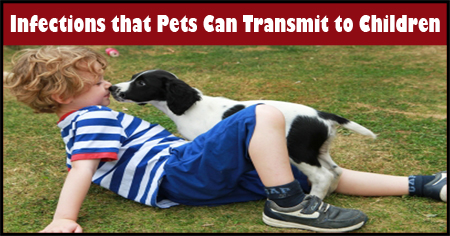Before getting pets for children parents must be aware of the infections that they carry and what must be done to prevent such infection. Let us take a look at the infections that pets can transfer to children.Children most often demand for pets in the house. Having a pet can teach children lots of lessons about caring for other living beings, to being responsible. There is nothing more delightful for children when it comes to loving pets. As delightful as a pet is, there are various health hazards associated with giving your child a pet. The infections transmitted by pets are called zoonotic infections. Pet carry germs, just like we do. These germs which are common among house pets are, mostly by contact, passed on to children, who are more vulnerable. Many infections are dangerous and can lead to serious health issues, like salmonella, transmitted by turtles and the like. Given below are infections carried by the most popular pets, cats and dogs. In this articleCampylobacter InfectionCat ScratchRabiesSpotted FeverRingwormCampylobacter InfectionThe pets that live in the house often carry campylobacter jejuni, a type of bacteria that can cause fever, stomach pain and even diarrhea in children. This kind of bacteria is generally present in the intestinal tract of animals. A child can get infected by this disease if they touch anything that is contaminated by a bacteria carrying pet.Young children are often not aware and may come in contact with the urine, vomit or feces of their pets. Through these the bacteria gets transmitted to the children. This infection is contagious and your child can even get them from school. Antibiotics are given to patients.Cat ScratchChildren very likely cuddle their pets, especially cats. The cats may lovingly scratch or nip its owner. If your child has been scratched or nipped by their feline companion, they might get infected by the bacteria known as bartonella henselae.Bartonella henselae is bacteria found exclusively in cats and can cause fever, headache, swollen lymph nodes and fatigue. This symptom is commonly called cat scratch symptom. Thankfully though, this disease causes no long term damage and gets healed without any treatment, though your doctor might prescribe some antibiotics if the child’s infection is chronic.RabiesThe most commonly known disease, it generally enters the body if a person is scratched or bitten or an open wound contaminated by the saliva of a pet carrying this disease. Dogs and cats, both carry rabies, though in recent years the number of infected animals has reduced due to pets getting vaccines against rabies. Vaccines are also available if a human is infected with rabies. You should observe your pet if they display signs of rabies and take them to the vet.Spotted FeverAnimals carry a lot of ticks that are attached to their skin. These ticks in turn carry bacteria called the rickettsia bacteria. Children can get this disease while caressing the fur of their pets or sleeping with them. The symptoms of this infection include chills, high fever, headache, muscle cramps. Some children are also seemed to develop a kind of rash spreading across their wrists, palms and mid section of the body. This too, can be treated with antibiotics.RingwormAnother popular disease of the pet, ringworm or tinea, a type of fungus that are generally found in the soil and may sometimes attach themselves to the skin of your pet. These ringworms are easily transmitted to children when they touch or cuddle their pets. This fungus can be found in cats and dogs. Affected part of the children’s skin may become flaky, reddish swollen, sometimes with bald patches on the scalp.Before you adopt or bring pets for your kids, visit a vet and get detailed information about the risks associated with it. After bringing your pet home, make sure that you vaccinate them properly and follow your vet’s instructions to prevent something happening to your child.Do pets carry infections? What kind of infections do pets carry? What can be done to prevent pets from transferring infections to children? Discuss here.
 Before getting pets for children parents must be aware of the infections that they carry and what must be done to prevent such infection. Let us take a look at the infections that pets can transfer to children.
Before getting pets for children parents must be aware of the infections that they carry and what must be done to prevent such infection. Let us take a look at the infections that pets can transfer to children.Children most often demand for pets in the house. Having a pet can teach children lots of lessons about caring for other living beings, to being responsible. There is nothing more delightful for children when it comes to loving
pets. As delightful as a pet is, there are various health hazards associated with giving your child a pet.
The infections transmitted by pets are called zoonotic infections. Pet carry
germs, just like we do. These germs which are common among house pets are, mostly by contact, passed on to children, who are more vulnerable. Many
infections are dangerous and can lead to serious health issues, like salmonella, transmitted by turtles and the like. Given below are infections carried by the most popular pets, cats and
dogs.
Campylobacter Infection
The pets that live in the house often carry campylobacter jejuni, a type of bacteria that can cause fever,
stomach pain and even diarrhea in children. This kind of bacteria is generally present in the intestinal tract of animals. A child can get infected by this disease if they touch anything that is contaminated by a bacteria carrying pet.
Young children are often not aware and may come in contact with the urine, vomit or feces of their pets. Through these the bacteria gets transmitted to the children. This infection is contagious and your child can even get them from school. Antibiotics are given to patients.
Cat Scratch
Children very likely cuddle their pets, especially cats. The cats may lovingly scratch or nip its owner. If your child has been scratched or nipped by their feline companion, they might get infected by the bacteria known as bartonella henselae.
Bartonella henselae is bacteria found exclusively in cats and can cause fever, headache, swollen lymph nodes and fatigue. This symptom is commonly called cat scratch symptom. Thankfully though, this disease causes no long term damage and gets healed without any treatment, though your doctor might prescribe some antibiotics if the child’s infection is chronic.
Rabies
The most commonly known disease, it generally enters the body if a person is scratched or bitten or an open wound contaminated by the saliva of a pet carrying this disease. Dogs and cats, both carry rabies, though in recent years the number of infected animals has reduced due to pets getting vaccines against rabies. Vaccines are also available if a human is infected with rabies. You should observe your pet if they display signs of rabies and take them to the vet.
Spotted Fever
Animals carry a lot of ticks that are attached to their skin. These ticks in turn carry bacteria called the rickettsia bacteria. Children can get this disease while caressing the fur of their pets or sleeping with them. The symptoms of this infection include chills, high fever, headache, muscle cramps. Some children are also seemed to develop a kind of rash spreading across their wrists, palms and mid section of the body. This too, can be treated with antibiotics.
Ringworm
Another popular disease of the pet, ringworm or tinea, a type of fungus that are generally found in the soil and may sometimes attach themselves to the skin of your pet. These ringworms are easily transmitted to children when they touch or cuddle their pets. This fungus can be found in cats and dogs. Affected part of the children’s skin may become flaky, reddish swollen, sometimes with bald patches on the scalp.
Before you adopt or bring pets for your kids, visit a vet and get detailed information about the risks associated with it. After bringing your pet home, make sure that you vaccinate them properly and follow your vet’s instructions to prevent something happening to your child.
Do pets carry infections? What kind of infections do pets carry? What can be done to prevent pets from transferring infections to children? Discuss here. 












 Before getting pets for children parents must be aware of the infections that they carry and what must be done to prevent such infection. Let us take a look at the infections that pets can transfer to children.Children most often demand for pets in the house. Having a pet can teach children lots of lessons about caring for other living beings, to being responsible. There is nothing more delightful for children when it comes to loving
Before getting pets for children parents must be aware of the infections that they carry and what must be done to prevent such infection. Let us take a look at the infections that pets can transfer to children.Children most often demand for pets in the house. Having a pet can teach children lots of lessons about caring for other living beings, to being responsible. There is nothing more delightful for children when it comes to loving 
















